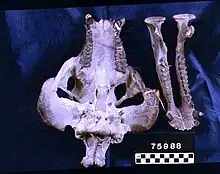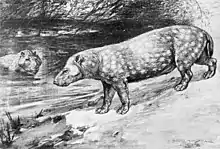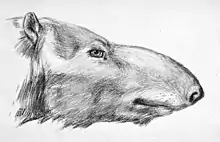| Merycochoerus Temporal range: Early Oligocene | |
|---|---|
 | |
| Merycochoerus superbus skull | |
| Scientific classification | |
| Domain: | Eukaryota |
| Kingdom: | Animalia |
| Phylum: | Chordata |
| Class: | Mammalia |
| Order: | Artiodactyla |
| Family: | †Merycoidodontidae |
| Genus: | †Merycochoerus Leidy 1858 |
| Type species | |
| †Merychochoerus proprius | |
| Species | |
|
see text | |
| Synonyms | |
| |
Merycochoerus (Greek: "ruminant" (merux)-like "swine" (khoiros)[1]) is an extinct genus of oreodont of the family Merycoidodontidae, endemic to North America. They lived during the Early Oligocene 33.9—30.8 mya, existing for approximately 3 million years.[2] Fossils are widespread through the western United States.

Restoration of M. carrikeri by Robert Bruce Horsfall

Restoration of M. proprius
Merycochoerus was a cud-chewing plant-eater with a long face, tusk-like canine teeth, heavy body, long tail, short feet, and four-toed hooves. The 1 metre (3.3 ft) long animals are thought to have been amphibious, as members of the genus possessed an elongated, barrel-shaped body and short limbs that are typical adaptations found in semi-aquatic mammals.[3]
Species
- M. carrikeri (syn. Promerycochoerus thomsoni)
- M. chelydra (syn. Promerycochoerus barbouri)
- M. magnus
- M. matthewi
- M. pinensis
- M. proprius
- M. superbus (syn. M. fricki, M. leidyi, M. macrostegus, M. montanus, M. temporalis, Promerycochoerus grandis, P. hatcheri, P. hollandi, P. inflatus, P. latidens, P. loomisi, P. lulli, P. marshi, P. microcephalus)
- M. vantasselensis
Resources
- ↑ "Glossary. American Museum of Natural History". Archived from the original on 20 November 2021.
- ↑ Merycochoerus at fossilworks
- ↑ Palmer, D., ed. (1999). The Marshall Illustrated Encyclopedia of Dinosaurs and Prehistoric Animals. London: Marshall Editions. p. 271. ISBN 1-84028-152-9.
This article is issued from Wikipedia. The text is licensed under Creative Commons - Attribution - Sharealike. Additional terms may apply for the media files.